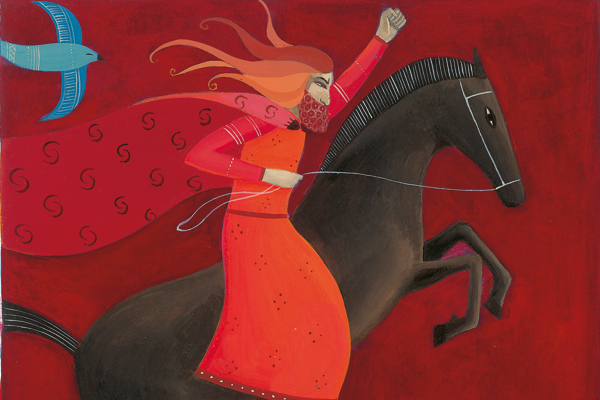There’s no shortage of magical rings in the children’s canon, the sort of things that usefully make you invisible or beautiful. But rings that can turn objects into a pile of excrement are something else. So one warms to Bianca Pitzorno’s Lavinia and the Magic Ring, translated from the Italian by Laura Watkinson (Catnip, £5.99) whose heroine, an orphaned match girl, is given one. Her subsequent adventures have more than a touch of Roald Dahl, being illustrated by Dahl’s co-creator, the ever fabulous Quentin Blake.
The sublime Judith Kerr is 95 and razor-sharp with it. Her latest, Mummy Time (HarperCollins, £12.99), is about the wonderful adventures, real and imagined, of a little boy in a park while his mother is on her mobile phone to a friend. Spot on.
The 30th anniversary of Dahl’s Matilda (Puffin, £12.99) means an anniversary edition, with new covers by Quentin Blake showing our heroine as astrophysicist and world explorer. Except the book, for all its anarchic brilliance, feels somewhat dated now, with the horrible people glued to a telly. These days, they’d be on separate screens. And personally I rather yearn for a Miss Trunchbull.
Another genius is Shirley Hughes, a mere 91. She is incapable of drawing a child or anyone else who isn’t lovable, and by some magic she sees the world as a child does. Her Snow in the Garden: A First Book of Christmas (Walker, £12.99), with Christmassy stories and things to do, would be a good present for the little ’uns. For slightly older children, Ruby in the Ruins (Walker, £12.99), is a sympathetic account of a young girl’s reaction to her father’s return from the war.
One illustrator I can never get enough of is David Lucas (check out his Christmas at the Toy Museum). I Was Made for You (Anderson, £11.95) is a charming account of a knitted cat whose question — ‘why was I made?’ — is finally answered after a very long journey.
If it’s poetry you’re after, I Am the Seed that Grew the Tree (Nosy Crow, £25) has a nature poem for each day, chosen by Fiona Waters, with bold, cheerful illustrations by Frann Preston-Gannon.
A new book by Maurice Sendak is a big deal, and in a way, that’s what Presto and Zesto in Limboland is (Bodley Head, £12.99). It’s based on pictures Sendak produced to accompany a staging of Janacek’s nursery-rhyme opera, Rikadla. Later, Sendak and his friend Arthur Yorinks came up with a narrative to tie the images together. The belated result is this nonsensical but satisfactory little story with sublime illustrations.
It’s strange how wedded a book and its illustrator become. Mary Poppins is the subject of a new film, so Harper Collins has republished the original stories by P.L. Travers (£6.99), with illustrations by Mary Shepard (daughter of The Wind in the Willows Shepard), which suggest Mary Poppins has a whiff of something terrible as well as reassuring about her. But in a bid to improve on perfection, there’s also a new edition illustrated by Lauren Child (HarperCollins, £20) which, she says, brings ‘a modernity perfectly suited to the story’. They’re delightful pictures, but she makes Mary Poppins pretty; to my mind that’s all wrong. But child fans of Child may love it. And she’s brilliant in her own right, of course, with an inimitable style. See her funny, subversive Hubert Horatio: How to Raise your Grown Ups, about a mature little boy with impossible, and impossibly rich, parents (HarperCollins £12.99).
It’s not every day you come across a new translation of The Arabian Nights, but the French Syrian writer, Yasmine Seale, has rendered afresh the 18th-century version of Aladdin by Antoine Galland, and has done a cracking job (Liveright, £12.99). It needs pictures though. Quite the opposite problem, then, from the reissue of the 1914 version of The Arabian Nights, translated by Laurence Housman, with exquisite illustrations by Edmund Dulac, reminiscent of Persian miniatures (Bodleian Library, £30). It’s lovely to look at, even if the prose might challenge young readers. If so, never mind them. Keep it for yourself.
If there is one really irritating category of modern children’s fiction it’s feminism as hagiography, as seen first in Goodnight Stories for Rebel Girls. There are endless variants. But the reductio ad absurdum of the genre, though that’s probably not how it’s intended, is Rebel Cats! Brave Tales of Feisty Felines by Kimberlie Hamilton (Scholastic, £8.99): inspirational tales about exceptional mogs, with useful facts about felines. But good for cat lovers, obviously.
As for brave, kind heroines, you can’t do better than A.L. Kennedy’s The Little Snake (Canongate, £9.99), about a girl who one day finds a handsome, vain snake wrapped round her ankle. It brings death, but they become friends. A lovely story, and good for readers of any age. But why no pictures?
There’s a less charming but tough, courageous heroine in Cornelia Funke’s little story, The Glass of Lead and Gold (Pushkin, £9.99), about a mudlark who makes a living digging objects from the Thames, including a magical shard which attracts dangerous attention. There’s something of Philip Pullman and J.K. Rowling here, and it’s evocatively illustrated by the author.
How my heart sinks at the prospect of a sequel to a famous book by another author; it never works. Apart, that is, from Katherine Rundell, who has, remarkably, managed it with Into the Jungle: Stories for Mowgli (Macmillan, £16.99). It’s not imitative of Kipling, and the tone is just right: a feat. It has intricate illustrations by Kristijana Williams; and if you haven’t already read the author’s Rooftoppers, get that too.
The ever brilliant New York Review of Books for Children has republished Eilis Dillon’s The Island of Horses (£7.99), an adventure about brave boys, a stolen horse and an island in the Atlantic: a story from a vanished Ireland. Quite wonderful.







Comments